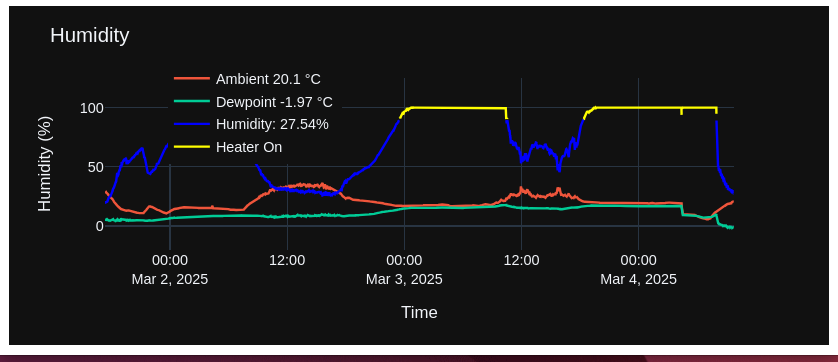Observed Conditions
Charts with 48 Hours of Conditions
Data is also Available on the API
Conditions are Updated Every 30 Seconds
(Click an Image for Larger View)

Cloud Cover
Measured between 0 and 100 where 0=clear sky and 100=100% cloud coverage. Clouds are measured during the daytime by atmospheric modeling and infrared data. Night coverage is determined by matching the bright star catalog against the camera image.

Starfwhm
The Full Width Half Maximum (FWHM) is a measure of the quality of an astronomical image based on how much the telescope and atmosphere have smeared a point source in an image over several pixels in the CCD. The lower an FWHM value is, the better, essentially sharper the image. A value of 2.0 or below, measured in arcseconds, is a good value for FWHM.

Temperatures
Measured ambient and sky temperature at the TychoCam™ in degrees Celsius as measured electronically a sensor.

Rain Rate
The units of this property are reported on the API in millimeters per hour. This data is provided by an infrared rain detector. ALPACA standards define levels of rain intensity as:
- Dry - No Rain
- Light - Rain 0.01-0.1
- Moderate - Rain 0.1-0.3
- Heavy - Rain 0.5-2.0
- Violent - Rain 2.0 +

Wind Speed
Measured by rotating mechanical wind cups at the TychoCam™ in kilometers per hour (kph).

Article
Wind Gust
Gusts are reported when the peak wind speed reaches at least 16 knots and the variation in wind speed between the peaks and lulls is at least 9 knots. By definition, the duration of a gust is usually less than 20 seconds, however, the TychoCam will extend this indication to 5 minutes.

Wind Direction
Measured at the TychoCam™ by a mechanical wind vane in degrees, 0-359 CW.

Dewpoint - Humidity
The dew point is the temperature to which air must be cooled to become saturated with water vapor, Calculated from temperature and humidity instruments at the TychoCam™.
Relative humidity is the amount of water vapor in the air, expressed as a percentage of the maximum amount of water vapor the air can hold at the same temperature. Measured directly by a humidity instrument mounted on the TychoCam™.

Sky Brightness
This property returns the sky brightness measured in Lux. The brightness of stars is measured in magnitudes with respect to an agreed upon reference, in this case, the Bright Star Catalog. A magnitude of 6.5 is on the edge of being seen by a human eye under perfect conditions, and is thus chosen as the cutoff.
| lux | Surfaces illuminated |
|---|---|
| .0001 | Moonless Overcast Night Sky |
| .002 | Moonless Clean Night Sky |
| .0.27–1.0 | Full moon on a clear night |
| 3.4 | Dark limit of civil twilight under clear sky |
| 50 | Moonless Clean Night Sky |
| 80 | Office building hallway/toilet lighting |
| 100 | Very dark overcast day |
| 320-500 | Office lighting |
| 1000 | Overcast day; typical TV studio lighting |
| 10000–25000 | Full daylight (not direct sun) |
| 32000–100000 | Direct sunlight |

Sky Quality
Sky quality is typically measured in units of magnitudes per square arc second. A sky quality of 20 magnitudes per square arc second means that the overall sky appears with a brightness equivalent to having 1 magnitude 20 star in each square arc second of sky.
| Quality | Description (Bortle Scale) |
|---|---|
| 22.0 | Moonless night sky free of light pollution |
| 21.0 | Glow of the brightest section of the northern Milky Way, from Cygnus through Perseus. |
| 20.0 | Outer suburbs of a major metropolis |
| 19.0 | Suburb with widely spaced single-family homes |
| 18.0 | Typical zenith skyglow at a rural site when the Moon is full. The Milky Way is invisible, or nearly so |
| 17.0 | Typical near the center of a major city |
| 13.0 | The zenith skyglow at the end of civil twilight, roughly a half hour after sunset, when the Sun is 6° below the horizon. Venus and Jupiter are easy to see, but bright stars are just beginning to appear. |
| 7.0 | The zenith skyglow at sunrise or sunset |